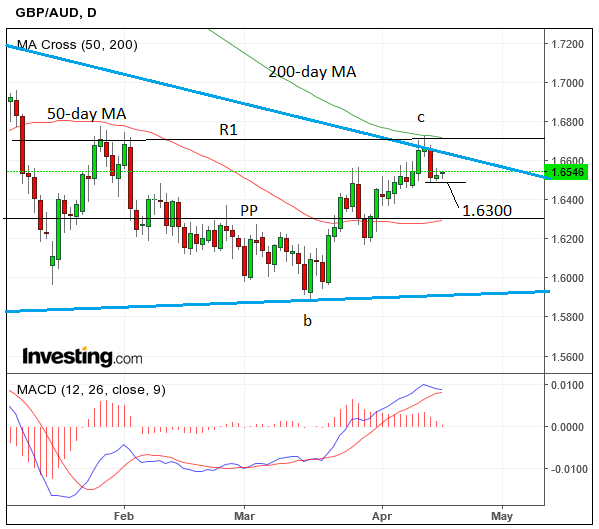Australian Dollar Softer after Easter Break but Could Still Push Sterling Lower

The Australian Dollar is softer as markets return from a long Easter weekend with the release of the minutes for the April Reserve Bank of Australia meeting weighing.
The Bank confirmed they remain wary of the economy's outlook and this has seen some increased selling of the currency.
However the outlook remains constructive against the Pound, from a technical angle at least.
The Pound to Australian Dollar exchange rate has been moving sideways in grand oscillations since the autumn of 2016.
These have, in fact, been part of a large triangle pattern which started forming with the rebound off the October 2016 lows.
The triangle has probably just completed its third wave, or ‘c’ wave, which ended at the 1.6700 level, at the upper border of the triangle and the 200-day moving average.
This is visible below:

Since then the exchange rate has rotated, rolled over, and started moving back down inside the triangle.
This tells us that the tide might have turned in favour of the Australian Dollar recently.
A large down day on Thursday April 13 saw the exchange rate fall from the 1.6700 level to just below 1.6500 in a day.
Since then there have been two small up days so far (assuming Monday April 17 ends higher than it opened).
Such a set-up composed of a long down day followed by two much smaller up days is a signal with a 66% probability that the following day will see more downside.
We expect a move below the 1.6486 lows would trigger a continuation down to a target situated at 1.6300, at the level of the Monthly Pivot (PP) and the 50-day MA.
RBA Minutes Halt Australian Dollar's Good Run
While technical studies confirm the Aussie Dollar is likely to outperform the Pound, we note the Reserve Bank of Australia has not been helping.
Minutes for the RBA's policy meeting held earlier in the month confirm the Bank is in no mood to raise interest rates anytime soon.
Recall that much of a currency's performance is derived by the decisions and processes undertaken at it's central bank and the rule of thumb is that higher interest rates lead to a stronger currency.
The Australian Dollar strengthened considerably on Thursday April 13 on the back of better-than-forecast jobs data which confirmed 60.9K new jobs had been created in Australia.
Analysts had only been expecting in the region of 20K jobs to be created.
The strength of the data had seen analysts take a more constructive view on the Australian economic outlook but there remains doubt as to whether the Reserve Bank of Australia will take much notice.
"Overall, the ongoing spare capacity in the labour market was contributing to low wage growth outcomes," read the RBA's minutes.
Furthermore, the RBA said the labour market warranted "careful monitoring" going forward.
Looking ahead, geopolitical machinations on investor risk appetite could be important as the Aussie tends to highly sensitive to such changes.
“Looking ahead, though, the Aussie is generally one of the first currencies to suffer when traders decide to limit their risks by seeking havens such as the Japanese Yen and gold. And it would be unwise at the moment to rule out a rise in risk-off sentiment given the ongoing turmoil in Syria, the approach of the French elections and – particularly – the belligerence of North Korea,” says Martin Essex of DailyFx.com.
Data for the Pound
The main data release for the Pound this week will be March Retail Sales, on Friday, April 21 at 9.30 GMT.
Expectations are not optimistic about the result due to recent disappointing Retail Sales data from the British Retail Consortium (BRC) overlapping the same period.
Analysts forecast headline sales to fall -0.2% compared to the previous month but to rise by 3.6% from the previous year.
Core retail sales expected to fall -0.3% from February and rise 4.0% year-on-year.
“U.K. retail sales are scheduled for release in the week ahead and while the uptick in wages points to a potential upside surprise, the British Retail Consortium reported weaker spending and after last month’s healthy rise, a pullback is expected. There’s significant resistance for GBP/USD between 1.25 and 1.2630,” said Kathy Lien, managing director of BK Asset Management.
"UK retail sales data is due out on Thursday, with analysts expecting a slight contraction in March retail sales. Any positive surprise could enhance GBP-bulls, while a disappointment could bring the BoE doves back to the market," says Ipek Ozkardeskaya at London Capital Group.




